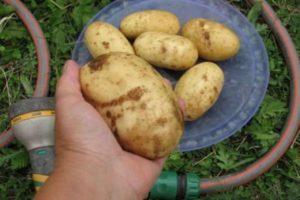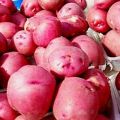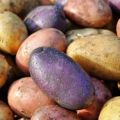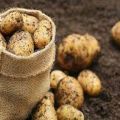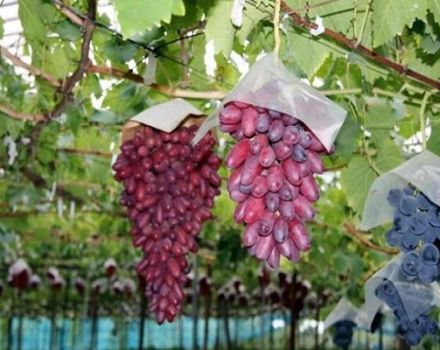Description of the Red Lady potato variety, cultivation features and yield
Many people buy a plot in order to get fresh natural vegetables and fruits from it. It is not surprising that potatoes are considered the most common crop in the garden. It is quite unpretentious, moreover, it turns out to collect a large amount of delicious harvest. In this article, you will learn what the Red Lady potato variety is and how to care for it.
Description of the variety
The Red Lady variety occupies a special place in agriculture. It was bred in Germany and entered into the register of Russia in 2008. This variety is suitable for the middle lane, as it is unpretentious to changes in weather conditions, easily tolerates drought.
The color of the peel is the characteristic by which the Lady Red variety is most often distinguished. It has a reddish tint, for which the potato got its name, literally meaning "red lady". The peel is smooth, thin, but strong, which allows the tubers to be transported and keep their presentation. They have few eyes, but they are superficial, which makes cleaning much easier. The tubers themselves are large in size, on average up to 150 g, and the yield of small defective tubers is minimal. The inside of the flesh is pale yellow in color.
This variety is amazing to taste - many gardeners who plant this variety share only positive reviews. This is probably one of the main reasons to try to drop the Red Lady.
Growing
Planting potatoes is not difficult even for beginners, and this variety is no exception.

Long before planting, the soil must be well fertilized, since the Red Lady variety requires a large amount of vitamins and minerals, and this is lacking in sandy loam soils (optimal for the species). To do this, during digging into the ground, they intervene:
- fresh manure;
- superphosphates;
- ammonium and potassium nitrate;
- bird droppings.
After winter, these substances will decompose to the elements optimal for the assimilation of potatoes.
When planting, it is worth considering a few simple rules, then you are guaranteed to get a high-quality harvest:
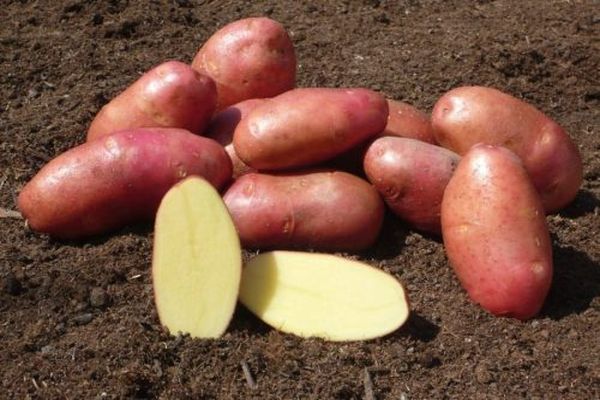
- Planting can be started as soon as the soil warms up to at least +10. This can be easily tracked by placing an ordinary thermometer on the site (stick it into the ground). Planting dates usually range from late April to early June. It all depends on the region and the climate in it.
- You can not plant potatoes after nightshades (tomatoes, eggplants), as well as after other varieties of this vegetable. It is also not recommended to place 2 different varieties next to each other - they will pollinate each other and lose their species characteristics.
- Dig the holes, keeping a distance of about 40 cm between them. There should be a distance of 60 cm between the rows.The holes themselves are usually made 30 cm deep.
- Planting material is usually prepared in advance.For this, tubers weighing about 90 g are suitable, smaller ones simply will not give a good harvest. To get an earlier harvest, potatoes are advised to germinate: it is enough to lay out the planting material in the sun for about a month.
- Before placing the tuber in the hole, it is advised to pour a handful of ash or ready-made complex fertilizers there. This will create a nutrient base for the future harvest.
Care features
As for watering planted potatoes, there are no clear rules and deadlines. The variety can easily tolerate drought, but is usually watered at least 2-3 times a month. During the rainy summer, you can remove it completely, since waterlogging will lead to the development of late blight.
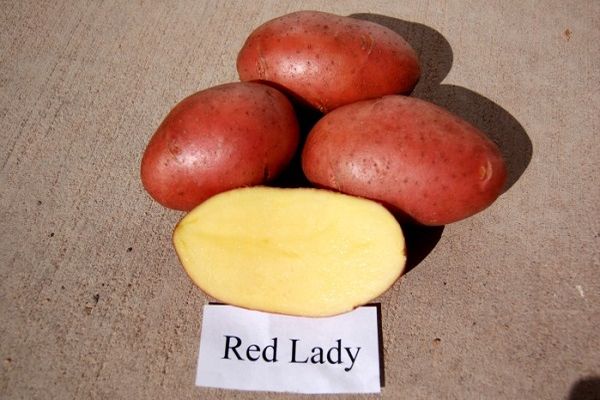
As mentioned above, Red Lady requires a lot of nutrients, so she needs regular feeding. Usually, an herbal infusion or a mixture of manure and water in a ratio of 1:10 is used.
Potatoes actively respond to such fertilizers, but you should not overdo it. An overabundance will lead to active growth of the aboveground part - a process that will take away strength from the development of tubers.
Weeding is considered mandatory in the care, it must be carried out regularly. Mulching with straw slows down the appearance of unwanted neighbors. In addition, it will retain moisture in the soil.
Advantages and disadvantages
It is worth saying that this variety has much more advantages than disadvantages. These include:
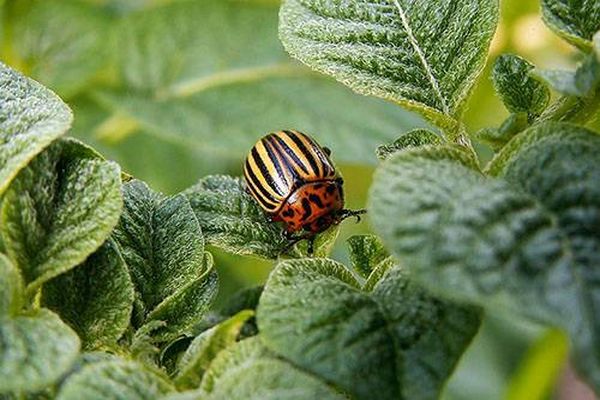
- early yield and extended growing season;
- abundant harvest and high content of nutrients in tubers;
- it is suitable for sale, since it does not lose its presentation during transportation, or its taste;
- the variety is bred resistant to many diseases, so there is practically no risk of losing the harvest.
But with so many positive aspects, there are also negative ones. Red Lady requires highly fertile soil, so it needs constant feeding. Also, long daylight hours are needed for good maturation. Despite the disease resistance, the variety is susceptible to late blight.
Pests and diseases
It was said above about resistance to diseases such as potato cancer, scab, golden potato nematode... But late blight can affect plant stems, in order to avoid this, regular preventive treatments with fungicides are carried out.

Some pests are not averse to eating potatoes, these include wireworm, Colorado potato beetle, bear. The description of the Colorado potato beetle is probably known to everyone. Complete destruction of the insect is impossible, therefore, in order to minimize losses, its larvae are collected and burned or thrown into a jar with strong saline solution.
In no case should beetles and larvae be crushed on the ground. Unfortunately, this method is only suitable for amateur planting; on an industrial scale, other methods will have to be used.
It is easy to "diagnose" the wireworm - single wilted bushes, when digging on the tubers there are small through holes. In the summer, it can be seen when weeding or loosening, since the larvae live in the upper layers of the soil during the warm period. It is difficult to get rid of it, so it is better to prevent the appearance of the pest in advance. There are several preventive measures:

- Compliance with agricultural technology and crop rotation. Some gardeners consider this an optional rule, but regularly planting the same crop leads to a decrease in fertility and disease.
- Remove all organic debris. Plant parts left in the ground will start to rot and will be ideal food for the pest, so carefully inspect the soil before wintering.
- Maintain a neutral PH level. The wireworm thrives in highly acidic soils.To find out this characteristic, you can take samples to the laboratory, but you can also pay attention to indicator plants. Plantain and sorrel are characteristic of high acidity, so the soil must be mixed with dolomite flour, lime.
- Planting protective plants such as dahlias, legumes (which are also considered excellent precursors for potatoes).
Harvesting and storage
This variety is harvested 55 days after germination, when the peak yield is reached. One bush can produce up to 15 potatoes.
The last harvest is carried out in August-September, after which the bushes are removed, and the soil is dug up according to all the rules. After harvest, the potatoes are placed in a vegetable pit, where the temperature does not drop below zero, as this will freeze and spoil the taste.
